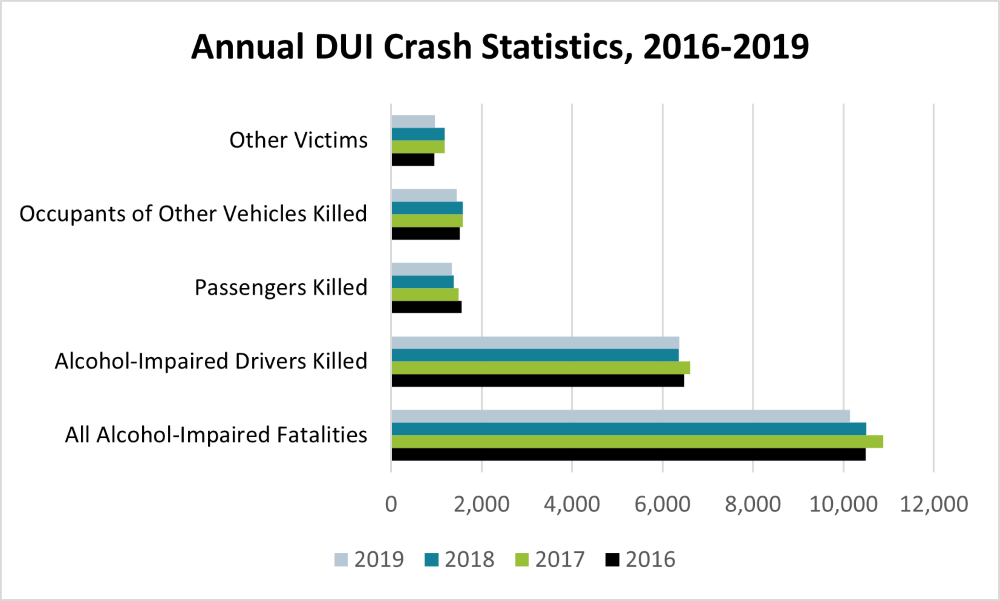Driving under the influence (DUI) can cause substantial harm to the impaired driver and anyone they encounter upon the road. DUIs can lead to single-vehicle collisions, multiple vehicle crashes, pedestrian accidents, and even severe structural damage that puts countless lives at risk. In this article, we explore key DUI facts and statistics in the United States. We primarily draw upon data from 2019, the most recent year for which data is available for most states.
What are the Different Types of Driving Impairments?
Driving under the influence of drugs or alcohol is a criminal offense in all states. Some states group all charges of impairment into one category, usually either DUI or driving while intoxicated/impaired (DWI). In states that only charge one of these offenses, the terms are frequently used interchangeably. When a state charges for both DUIs and DWIs, a DWI typically refers to impairment by drugs and a DUI typically relates to alcohol.
State-by-State DUI Fatality Statistics
Using public data provided by the National Highway Traffic Safety Administration (NHTSA), we tracked key DUI statistics across the U.S. in 2019. We primarily focused on fatal accidents. In the chart below, you can see the highest blood alcohol concentration (BAC) amongst all drivers involved in a collision and the percentage of a state’s fatal accidents that were alcohol related.
Notable findings:
- In some order, California, Texas, and Florida had the highest number of crash-related fatalities in all three tracked BAC categories. According to the United States Census Bureau, these three states also had the highest populations in 2019.
- The District of Columbia (26), Vermont (49), and Rhode Island (71) had the least crash-related deaths amongst our tracked categories.
- In 20 states, at least 30% of traffic-related fatalities involved one or more impaired drivers.
- The states with the highest percentages of alcohol-related crash fatalities were Rhode Island (44%), North Dakota (41%), and New Hampshire (40%). Despite having such a high percentage of alcohol-impaired fatalities, Rhode Island’s overall population was only at 1.06 million in 2019, resulting in less lethal accidents than more populous states.
| State | # Fatalities, Highest Driver BAC = 0 | # Fatalities, Highest Driver BAC = 0.08+ | # Fatalities, Highest Driver BAC = 0.15+ | % Statewide Fatal Crashes Involved Alcohol |
|---|---|---|---|---|
| Alabama | 603 | 277 | 187 | 30% |
| Alaska | 41 | 22 | 12 | 28% |
| Arizona | 670 | 260 | 176 | 27% |
| Arkansas | 347 | 128 | 89 | 25% |
| California | 2,473 | 949 | 630 | 28% |
| Colorado | 395 | 164 | 121 | 27% |
| Connecticut | 139 | 94 | 61 | 38% |
| Delaware | 97 | 31 | 24 | 24% |
| District of Columbia | 15 | 6 | 5 | 26% |
| Florida | 2,258 | 790 | 529 | 25% |
| Georgia | 1,066 | 353 | 224 | 24% |
| Hawaii | 62 | 36 | 20 | 38% |
| Idaho | 143 | 68 | 51 | 34% |
| Illinois | 640 | 314 | 213 | 31% |
| Indiana | 576 | 210 | 145 | 26% |
| Iowa | 212 | 100 | 67 | 30% |
| Kansas | 311 | 91 | 59 | 22% |
| Kentucky | 552 | 150 | 106 | 20% |
| Louisiana | 473 | 220 | 144 | 30% |
| Maine | 99 | 50 | 36 | 32% |
| Maryland | 332 | 167 | 112 | 32% |
| Massachusetts | 202 | 110 | 78 | 33% |
| Michigan | 681 | 261 | 169 | 26% |
| Minnesota | 262 | 86 | 58 | 24% |
| Mississippi | 443 | 170 | 118 | 26% |
| Missouri | 598 | 235 | 154 | 27% |
| Montana | 113 | 66 | 50 | 38% |
| Nebraska | 177 | 58 | 38 | 24% |
| Nevada | 191 | 92 | 66 | 30% |
| New Hampshire | 55 | 40 | 29 | 40% |
| New Jersey | 391 | 129 | 81 | 23% |
| New Mexico | 267 | 129 | 89 | 31% |
| New York | 614 | 262 | 170 | 28% |
| North Carolina | 1,002 | 323 | 215 | 24% |
| North Dakota | 52 | 41 | 32 | 41% |
| Ohio | 727 | 351 | 232 | 30% |
| Oklahoma | 457 | 154 | 120 | 24% |
| Oregon | 283 | 167 | 118 | 22% |
| Pennsylvania | 712 | 298 | 204 | 28% |
| Rhode Island | 27 | 25 | 19 | 44% |
| South Carolina | 671 | 285 | 197 | 28% |
| South Dakota | 70 | 28 | 18 | 27% |
| Tennessee | 800 | 290 | 201 | 26% |
| Texas | 2,068 | 1,332 | 890 | 37% |
| Utah | 199 | 39 | 26 | 16% |
| Vermont | 33 | 9 | 7 | 19% |
| Virginia | 548 | 236 | 171 | 28% |
| Washington | 310 | 172 | 119 | 37% |
| West Virginia | 196 | 56 | 36 | 22% |
| Wisconsin | 361 | 183 | 126 | 32% |
| Wyoming | 100 | 36 | 30 | 25% |
| U.S. Totals | 24,114 | 10,143 | 6,872 | N/A |
Alcohol-Influenced Motorcycle Statistics
A comprehensive study by Salter, Healy, Rivera & Heptner tracks alcohol-impaired motorcycle fatalities in 2019. We can see that, in addition to leading all states in the percentage of total fatal accidents involving alcohol, Rhode Island also has the highest percentage of alcohol-influenced motorcycle deaths. Florida, California, and Texas again lead all states in the overall number of traffic-related fatalities, including those where a motorcyclist had a BAC of 0.08 or higher.
| Rank | State | Total # Fatalities | BAC .08+ | % Fatalities With BAC .08+ |
|---|---|---|---|---|
| 1 | Rhode Island | 11 | 7 | 64% |
| 2 | Iowa | 38 | 17 | 44% |
| 2 | Massachusetts | 44 | 20 | 44% |
| 4 | Wyoming | 12 | 5 | 43% |
| 5 | Montana | 22 | 9 | 42% |
| 6 | Connecticut | 43 | 18 | 41% |
| 7 | West Virginia | 27 | 11 | 39% |
| 8 | Idaho | 24 | 9 | 37% |
| 8 | Illinois | 131 | 48 | 37% |
| 8 | Texas | 400 | 147 | 37% |
| 11 | New Jersey | 79 | 28 | 36% |
| 12 | Virginia | 93 | 32 | 35% |
| 13 | Delaware | 15 | 5 | 34% |
| 13 | Kansas | 36 | 12 | 34% |
| 13 | Louisiana | 85 | 29 | 34% |
| 13 | Minnesota | 41 | 14 | 34% |
| 17 | Ohio | 148 | 49 | 33% |
| 18 | North Dakota | 9 | 3 | 32% |
| 18 | South Carolina | 140 | 45 | 32% |
| 20 | Alabama | 90 | 27 | 30% |
| 20 | Colorado | 93 | 28 | 30% |
| 20 | Maine | 25 | 8 | 30% |
| 20 | Michigan | 126 | 38 | 30% |
| 20 | Nebraska | 24 | 7 | 30% |
| 20 | New Mexico | 49 | 15 | 30% |
| 26 | Indiana | 120 | 35 | 29% |
| 26 | New Hampshire | 27 | 8 | 29% |
| 26 | Washington | 89 | 26 | 29% |
| 26 | Wisconsin | 79 | 23 | 29% |
| 30 | Oregon | 53 | 15 | 28% |
| 30 | Tennessee | 147 | 42 | 28% |
| 32 | Arizona | 169 | 46 | 27% |
| 32 | California | 451 | 123 | 27% |
| 32 | District of Columbia | 3 | 1 | 27% |
| 32 | Florida | 559 | 149 | 27% |
| 36 | Hawaii | 20 | 5 | 26% |
| 36 | Nevada | 55 | 14 | 26% |
| 36 | New York | 129 | 33 | 26% |
| 39 | Alaska | 4 | 1 | 25% |
| 39 | Maryland | 71 | 18 | 25% |
| 39 | Oklahoma | 66 | 17 | 25% |
| 42 | Missouri | 120 | 29 | 24% |
| 42 | Pennsylvania | 166 | 39 | 24% |
| 44 | Georgia | 164 | 38 | 23% |
| 44 | North Carolina | 203 | 48 | 23% |
| 46 | Mississippi | 37 | 8 | 22% |
| 47 | Utah | 34 | 7 | 21% |
| 48 | Arkansas | 58 | 12 | 20% |
| 49 | Kentucky | 83 | 16 | 19% |
| 50 | Vermont | 7 | 1 | 16% |
| 51 | South Dakota | 14 | 2 | 15% |
Annual DUI Crash Facts & Figures
From 2016-2019, the U.S. experienced no less than 10,142 annual alcohol-impaired crash fatalities. In addition to the tremendous cost in lives lost, DUI crashes caused considerable property and economic damages. In the state of Arizona alone, the costs associated with property damage, fatal crashes, and collision injuries in 2020 totaled $17,193,082,878 in economic damages.
Can I File a Lawsuit Against a Drunk Driver?
If you or a loved one suffered injury in a crash caused by an impaired driver, you may be wondering if you have grounds to sue. It’s important to note that every personal injury case is unique, and you should always speak to a local attorney that is familiar with your state’s laws and jurisdictions. Depending on the state you live in and the circumstances, you may be subject to:
- No-fault laws: If you live in a no-fault state, there is a threshold in place preventing you from filing suit for a motor vehicle crash unless your damages exceed a mandated dollar amount or your wounds are of a statutory severity. If you suffered minor injuries or property damage, you will most likely be unable to file a civil suit and will need to reach out to your insurance company.
- Pure negligence laws: In a state with pure negligence personal injury laws, you are most likely free to sue a drunk driver for injuries sustained. You will need to prove fault, as in any other personal injury lawsuit.
- Wrongful death laws: If a loved one is killed by an impaired driver, you may be able to bring a wrongful death lawsuit against the responsible motorist. Depending on the circumstances, you may be able to recover economic, non-economic, and punitive damages.





No Comment